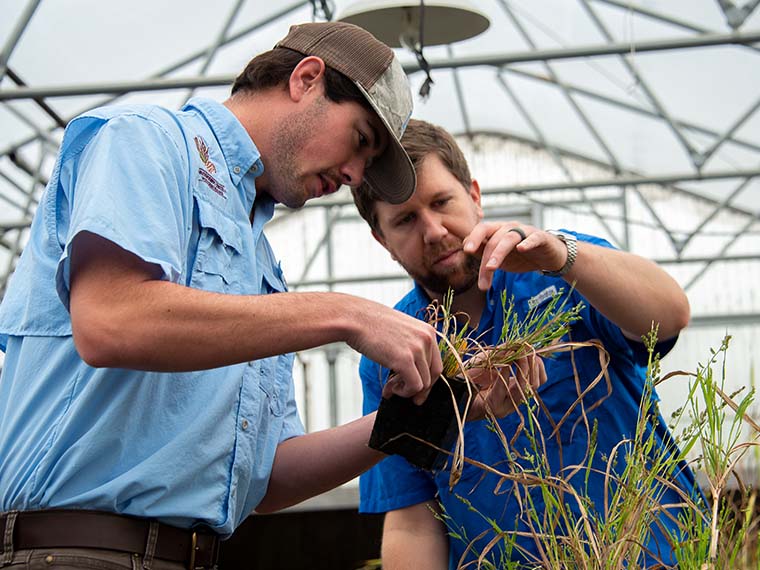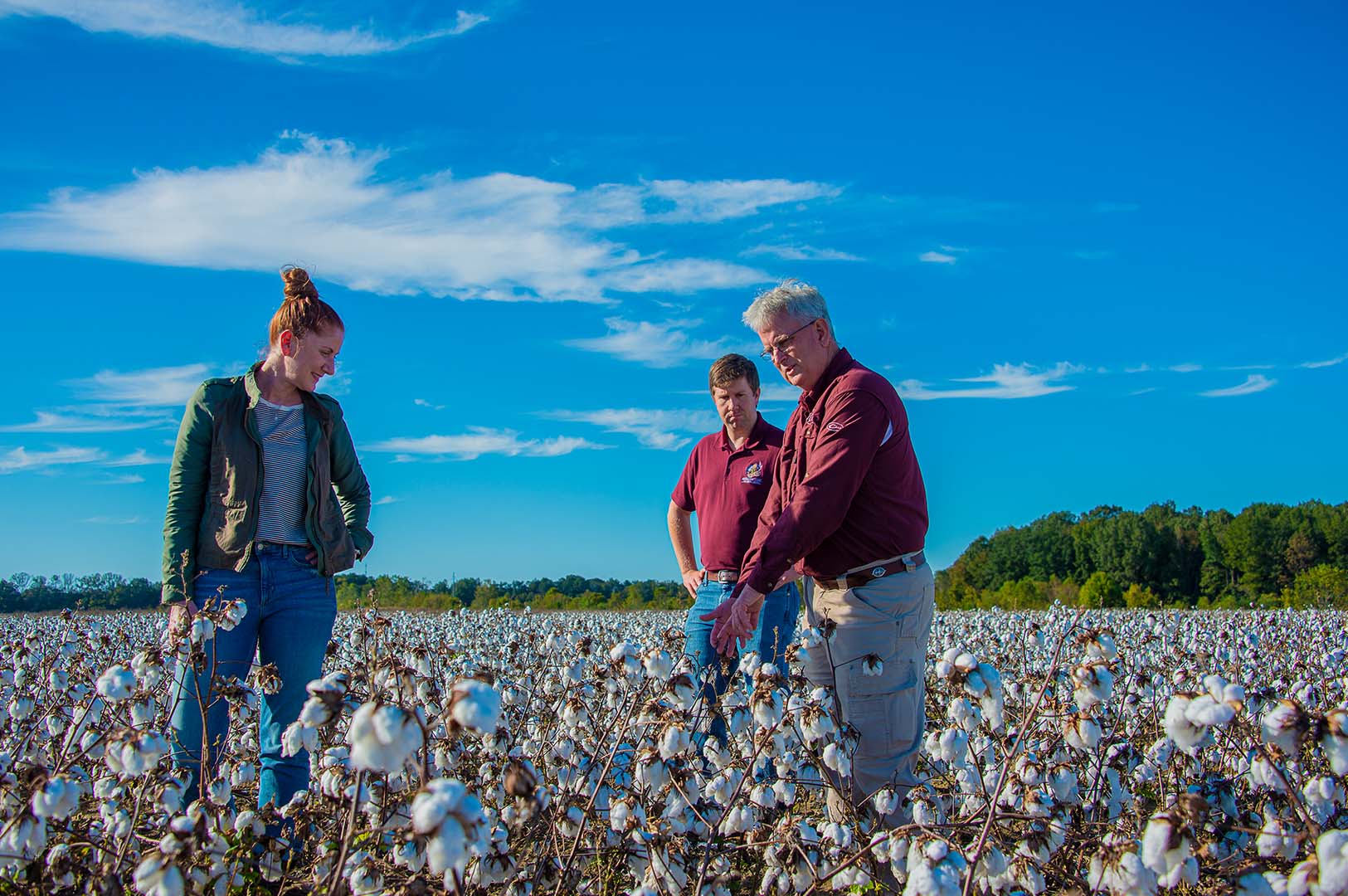The information presented on this page may be dated. It may refer to situations which have changed or people who are no longer affiliated with the university. It is archived as part of Mississippi State University's history.
PLAIN AND SIMPLE: plants fight for resources. In addition to eradicating weeds, producers must also fight common grasses that compete for vital nutrients. Oftentimes, this means using two different herbicides in soybean and cotton. Farmers use synthetic auxin technologies, like 2,4-D and dicamba, to wipe out broadleaf weeds and glyphosate to kill common grasses. For cost saving and convenience, producers often mix each of these herbicides in the spray tank, using the same spray lines and booms, so they can address both issues with a single pass across the field, saving time and fuel. This practice, however, often leads to herbicide antagonism, when one herbicide renders the other less effective. Researchers in the Mississippi Agricultural and Forestry Experiment Station hope to find application methods to curb this antagonism in a way that's effective, cost-efficient, and easy for growers to adopt.
Dr. Connor Ferguson, assistant professor in the Department of Plant and Soil Sciences and MAFES researcher, is leading the work.
"As a weed scientist, dead weeds make me happy," Ferguson said. "Not only do weeds and grasses compete for the same resources as crops, when it comes time to harvest, more weeds and grasses in the field hinder an effective harvest. Soybean and cotton farmers want as few weeds and as little grass as possible, so they can harvest the greatest amount of beans and fiber quantity, respectively."
What began as a two-year project supported by a MAFES Special Research Initiative, or SRI, grant has been expanded into a large-scale three-year study funded by a $300,000 Critical Agricultural Research and Extension, or CARE, grant through the U.S. Department of Agriculture's National Institute of Food and Agriculture.
"New auxin herbicide tolerant cotton and soybean varieties allow for the use of 2,4-D and dicamba to be applied over the top of the crop, resulting in effective broadleaf weed control. Since these varieties came online, however, growers have experienced significant reduction in grass weed control due to herbicide antagonism," explained Ferguson, who noted these varieties account for 80 percent of cotton and 95 percent of soybean acres across the South.
In studying how these herbicides are applied together in the field, the team hypothesized that the longer the auxin and grass control herbicides (glyphosate and clethodim) were mixed, the greater the antagonism would be. They hoped different spray techniques would reduce that antagonism. Through three trials in the field and four in the greenhouse, they studied antagonism across three grass species. Researchers tried different methods of applying the two herbicides separately to reduce antagonism.
"In the field, we found that applying the herbicides through separate tanks, lines, and booms where the chemicals only mixed on the plants eliminated herbicide antagonism," Ferguson said.
The team also studied different application sequences in the greenhouse trials where glyphosate was applied before auxin and vice versa. They saw no antagonism when glyphosate or clethodim was applied before auxin but saw antagonism when auxin was applied first.
Now the researchers will focus on fine-tuning novel application methods, including using a separate spray boom, to make them feasible at the farm level.
"We want to modify existing equipment that would prevent the grower from having to purchase a new sprayer to overcome antagonism," Ferguson said. "Our goal is to improve application methods where the herbicides are applied separately and further develop those methods to ensure that scaling them up for a commercial grower can be accomplished while overcoming antagonism."
Plant and soil sciences researchers are partnering with the Mississippi State Chemical Laboratory to quantify the antagonism observed visually in the field and better understand why the antagonism occurs in hopes of developing better field solutions to overcome it.
Dr. Ashli Brown, state chemist and professor in the Department of Biochemistry, Molecular Biology, Entomology and Plant Pathology, who oversees the Mississippi State Chemical Laboratory, explained her team's role.
"We house the capabilities and instrumentation to analyze the plant's chemical compounds in order to see what's happening chemically inside the plant," Brown explained.
The team applied the combination and sequences of the two different herbicides across treatments compared to a control of a glyphosate-only application. Then, after 24 hours, they harvested, collected, and processed the uppermost blades of the grasses, which would have the highest concentration of chemicals. From there, researchers used liquid or gas chromatography-mass spectrometry to quantify the amount of herbicide in each plant. Thus far, the chemical analysis has mirrored what they've observed visually.
"If we can answer the question of why and how these herbicides antagonize each other, we can better solve the problem," Brown explained.
She said she's most excited how the work can benefit farmers down the road.
"Our hope is that this research will lead to systems that can use less herbicides more efficiently, which is better for everyone. Herbicides, insecticides, and fertilizer cost farmers hundreds of dollars a year. Anytime you can better understand how herbicides are working and improve the ways in which they can be applied and have that translate to the farm, that practicality is huge. Our goal is to help producers fine tune their herbicide management plan so it's more effective and cost less," she said.
Dr. Dan Reynolds, a weed science professor and MAFES researcher on the project, is most excited about the team.
"I'm excited about Dr. Ferguson taking the lead and tackling this project as a young faculty member. I think it's a testament to his determination. He's been a great addition to the team with plenty of years of research ahead of him. I also think partnering with Dr. Brown and the Mississippi State Chemical Lab provides both critical insight and a unique learning experience for the students involved in the research," Reynolds said.
Reynolds, who is currently interim associate vice president for international programs and executive director of the university's International Institute, pointed out the project's extension objective to disseminate the information to growers. He said it all comes down to helping out producers.
"This research is an example of how necessity is the mother of all invention. Our producers were observing antagonism that hindered herbicide efficacy, so we saw this as an issue we needed to investigate. We consider our producers our clientele and when they have an issue, we try to find a way to remediate the problem," he said.
The research was funded by a Mississippi Agricultural and Forestry Experiment Station Special Research Initiative grant and a Critical Agricultural Research and Extension, or CARE, grant through the U.S. Department of Agriculture's National Institute of Food and Agriculture. Ten plant and soil sciences students and two biochemistry students have participated in the research, including master's student Luke Merritt and current plant and soil sciences doctoral student Jake Patterson. Merritt, who graduated in December 2019, based his master's thesis on work conducted during the MAFES-funded portion of the research while Patterson's dissertation will focus on the current research funded through CARE.
Our goal is to improve application methods where the herbicides are applied separately and further develop those methods to ensure that scaling them up for a commercial grower can be accomplished while overcoming antagonism.
Dr. Connor Ferguson


